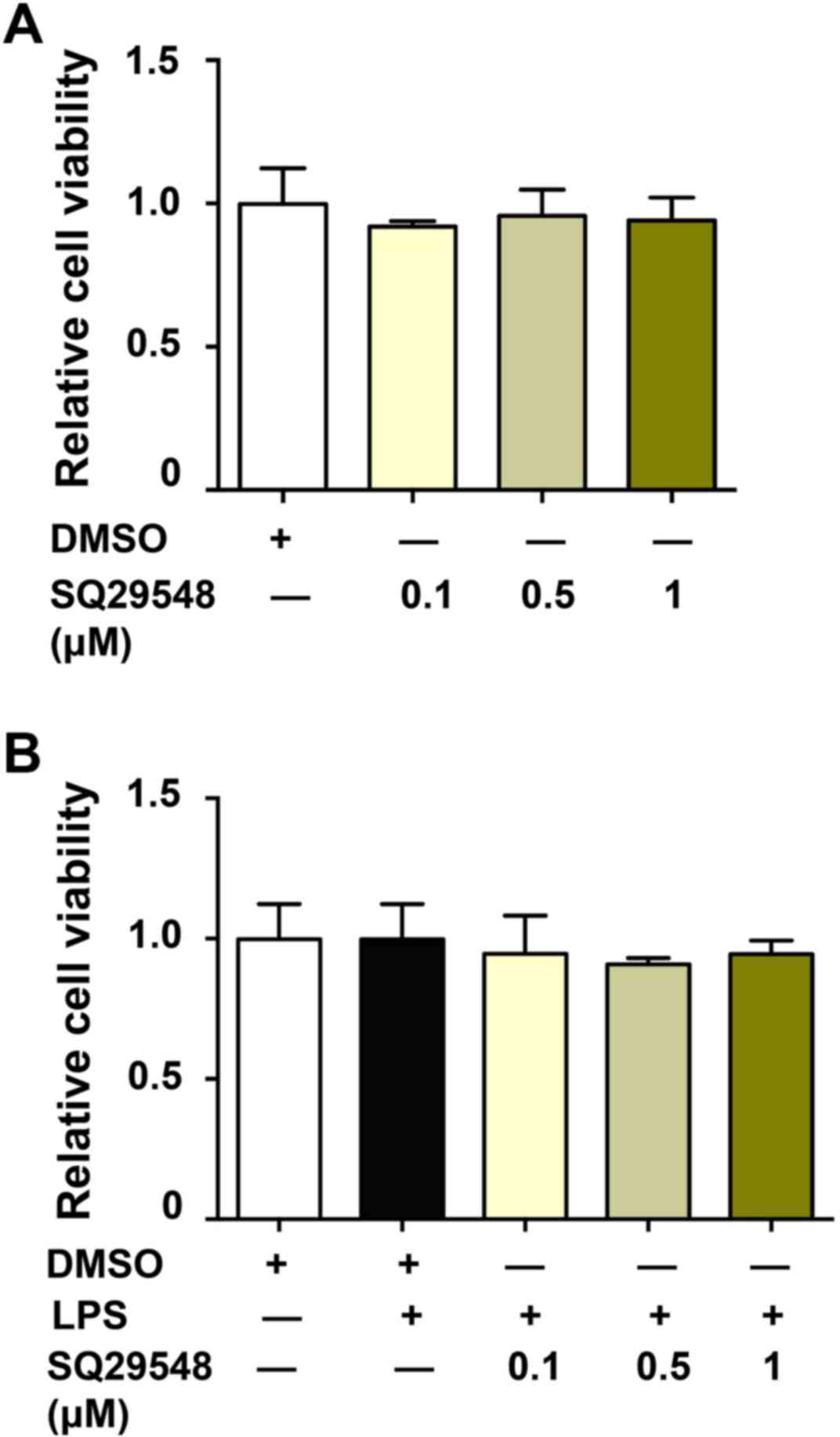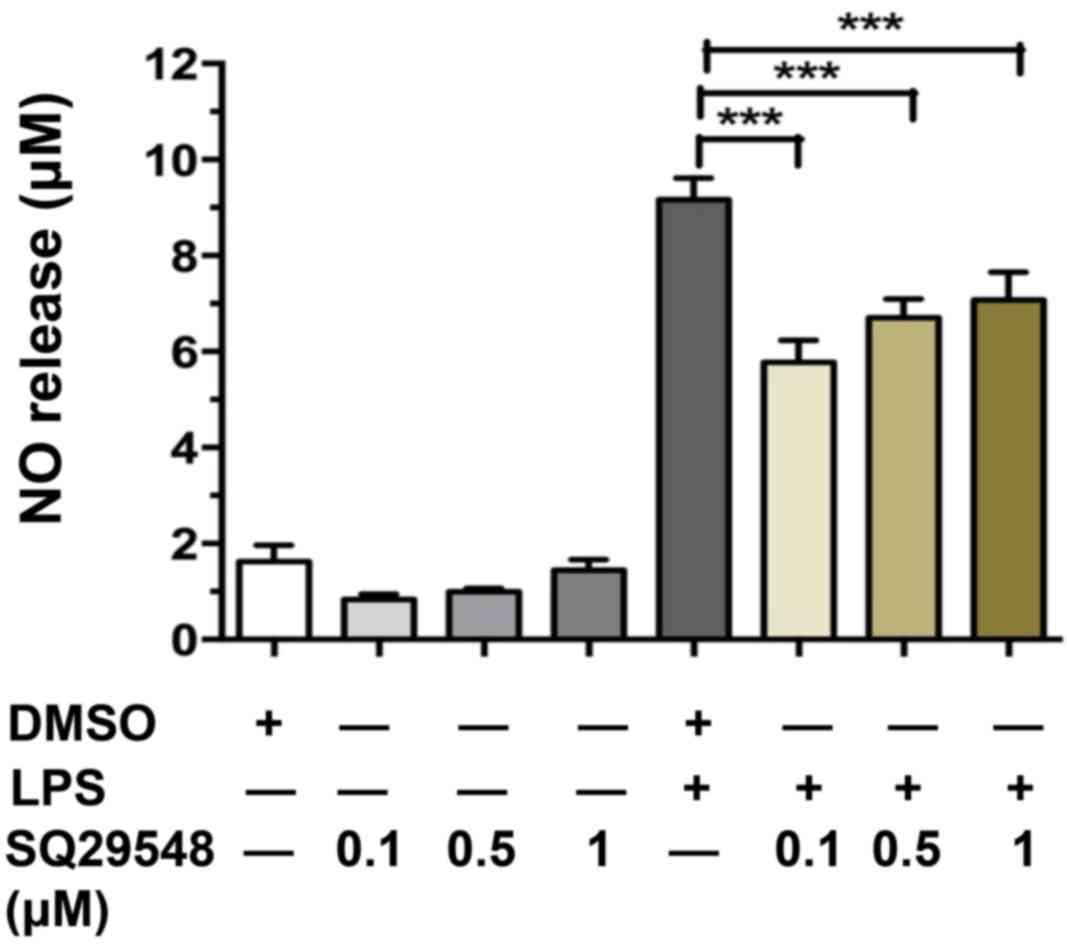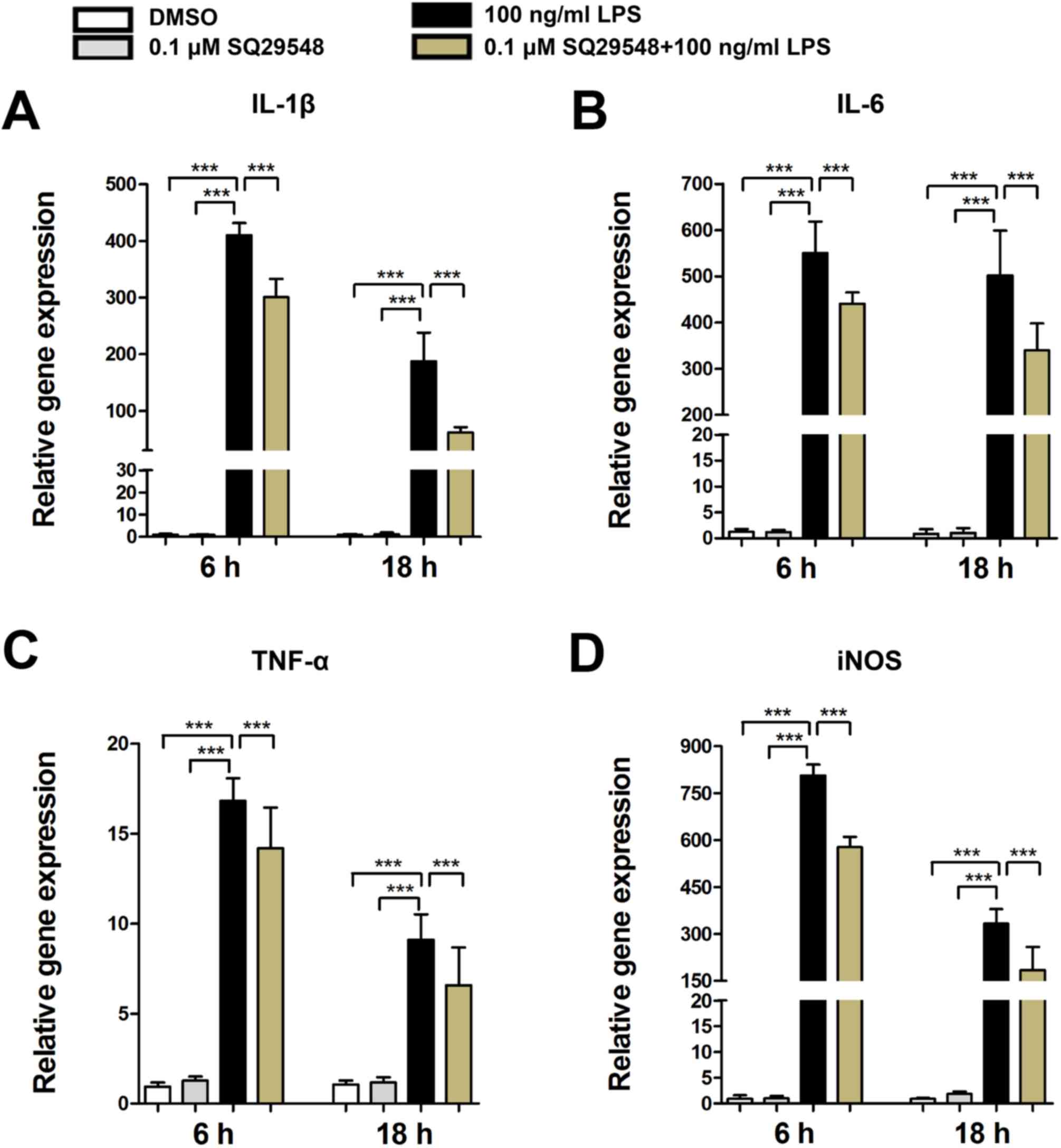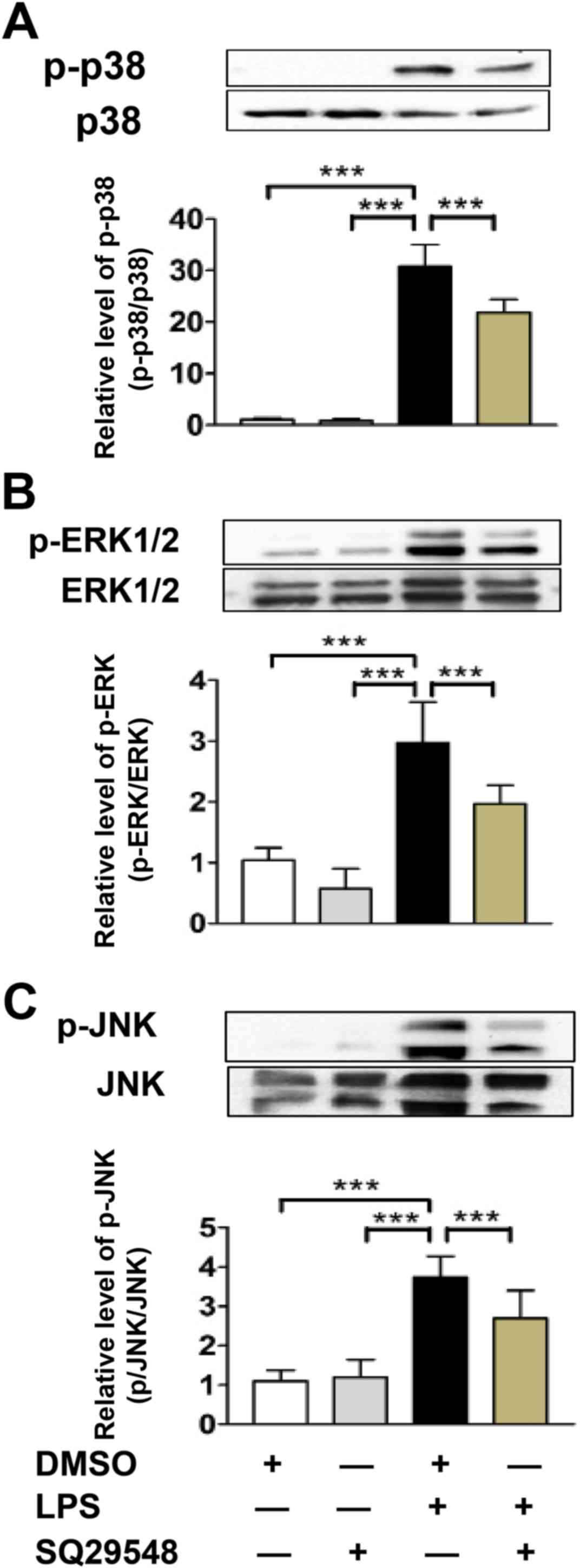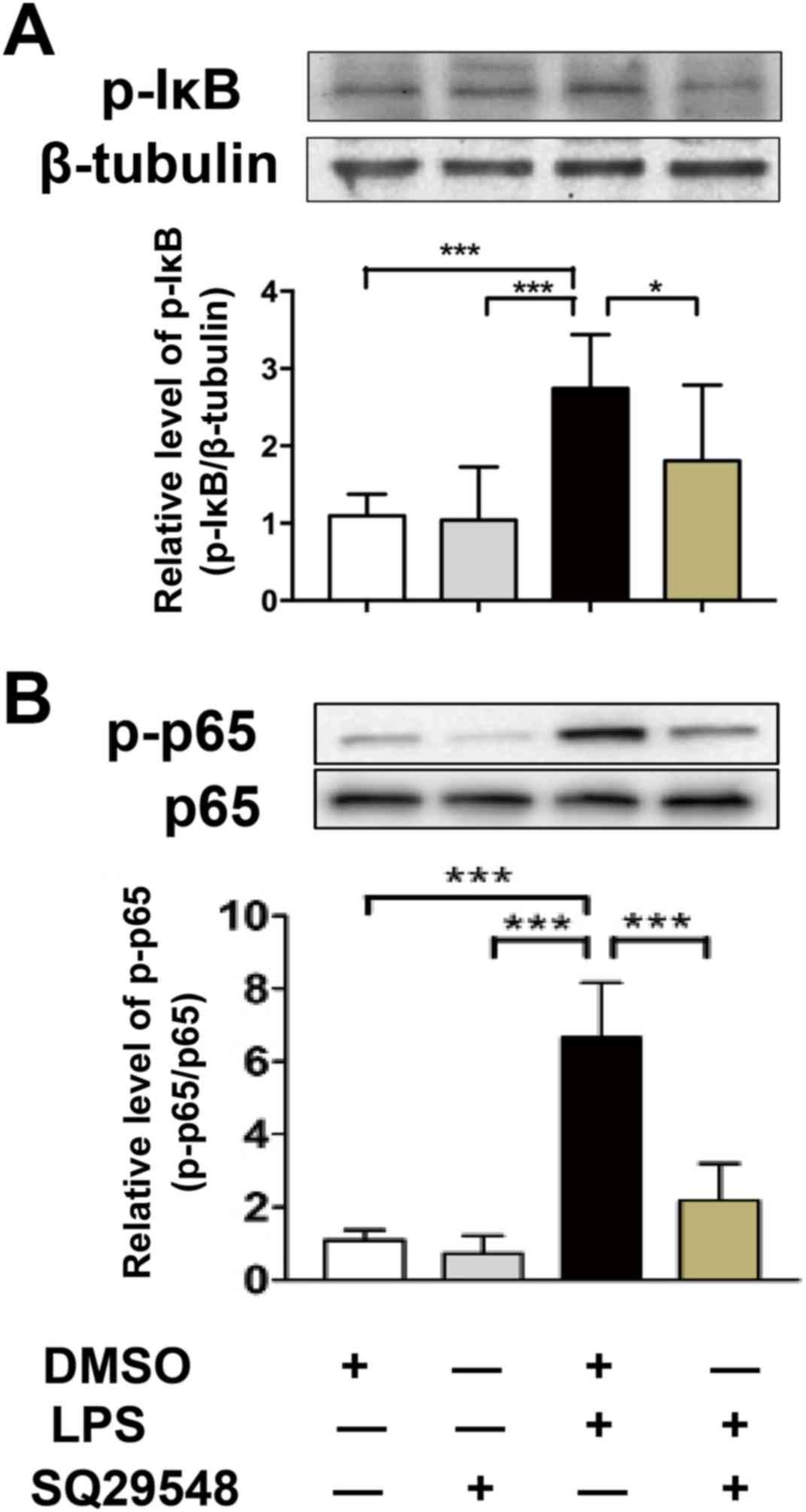Thromboxane A2 receptor antagonist SQ29548 suppresses the LPS‑induced release of inflammatory cytokines in BV2 microglia cells via suppressing MAPK and NF‑κB signaling pathways
- Authors:
- Published online on: June 29, 2017 https://doi.org/10.3892/mmr.2017.6884
- Pages: 2491-2496
-
Copyright: © Yan et al. This is an open access article distributed under the terms of Creative Commons Attribution License.
Abstract
Introduction
Microglia are resident immune cells of the central nervous system and respond to microenvironmental changes (1). Activation of microglia contributes to inflammatory responses in certain neuronal disorders, such as ischemic stroke (2). In response to injury, microglia become activated and secrete inflammatory factors, including interleukin (IL)-1β, tumor necrosis factor (TNF)-α, IL-6 and nitric oxide (NO) (3). Previous studies demonstrated that inhibition of microglia activation reduces the severity and improves the neurological outcomes of neurodegenerative diseases (4).
Lipopolysaccharides (LPS), a primary constituent of Gram-negative bacteria, are key in the initiation of inflammation mediated by Toll-like receptor 4 (5). LPS activates BV2 microglial cells by releasing IL-1β, IL-6, TNF-α and inducible NO synthase (iNOs) (6). Thus, the LPS-stimulated BV2 microglial model is useful for investigating the underlying mechanisms of neurodegenerative diseases that are mediated by pro-inflammatory cytokines (7).
The thromboxane A2 receptor (TXA2R) is a seven-transmembrane G-protein-coupled receptor localized on the cell membrane and in intracellular compartments (8). In the central nervous system, numerous types of cells, such as microglia (9), oligodendrocytes (10) and astrocytes (11) express TXA2R. Stimulation of TXA2R in astrocytes results in the secretion of the inflammatory cytokine, IL-6 (12). Furthermore, previous studies demonstrated that the TXA2R agonist U46619 may activate BV2 microglia to release inflammatory cytokines, whereas the release of inflammatory cytokines may be inhibited by SQ29548 (13). SQ29548 is a highly selective TXA2R receptor antagonist, which abolishes the majority of the biological actions of TXA2R. In a previous study, human platelet reactions to collagen and epinephrine, involving the generation of endogenous TXA2R, were effectively antagonized by SQ29548, and platelet aggregation was induced by adding arachidonic acid (14).
The function of TXA2R antagonists in LPS-stimulated BV2 microglial cells remains unknown. Thus, the current study focuses on the anti-inflammatory effects of SQ29548 on LPS-stimulated BV2 microglial cells and its molecular mechanisms. The aim of the study was to determine the toxicity of SQ29548 on BV2 microglial cells and elucidate the effects of the TXA2R antagonist on the LPS-induced inflammatory response in BV2 microglial cells.
Materials and methods
Reagents
The TXA2R receptor antagonist (SQ29548), LPS and dimethyl sulfoxide (DMSO) were purchased from Sigma-Aldrich (Merck KGaA, Darmstadt, Germany). SQ29548 was dissolved in DMSO.
BV2 microglial cell culture
The BV2 microglial cell line was provided by the Institute of Neurology, Rui Jin Hospital (Shanghai, China). The cells were cultured in Dulbecco's modified Eagle's medium (Gibco; Thermo Fisher Scientific, Inc., Waltham, MA, USA) supplemented with 10% heat-inactivated fetal bovine serum (Gibco; Thermo Fisher Scientific, Inc.) at 55°C for 30 min, and 1% penicillin/streptomycin at 37°C for 48 h in a humidified incubator with an atmosphere of 5% CO2.
Cell viability assay
The BV2 cells were seeded at 4.0×103 cells/ml in 96-well plates and treated with various doses of SQ29548 (0.1, 0.5, or 1.0 µM) for 30 min, followed by treatment with LPS (100 ng/ml) for 24 h at 37°C. Cell viability was examined using a Cell Counting kit (CCK)-8 assay (Nanjing KeyGen Biotech Co., Ltd., Nanjing, China) according to the manufacturer's instructions.
NO measurement
The BV2 cells were seeded at 1.0×105 cells/ml in 24-well plates and treated with various SQ29548 concentrations (0.1, 0.5 or 1.0 µM) for 30 min, followed by LPS (100 ng/ml) for 24 h. Following incubation at 37°C for 24 h, culture supernatants were collected, and the NO concentration was measured using an NO Griess reaction assay kit (Beyotime Institute of Biotechnology, Haimen, China) according to the manufacturer's instructions.
Reverse transcription-quantitative polymerase chain reaction (RT-qPCR)
BV2 cells, seeded at 2.0×105 cells/ml in 12-well plates, were pre-treated with SQ29548 (0.1 µM) for 30 min, followed by LPS (100 ng/ml) treatment for 6 or 18 h at 37°C. Total RNA from BV2 cells was isolated using TRIzol® reagent (Invitrogen; Thermo Fisher Scientific, Inc., Waltham, MA, USA) and was reverse transcribed to cDNA using the PrimeScript RT Reagent kit (Takara Bio, Inc., Otsu, Japan). qPCR was performed on cDNA using an SYBR Green kit (Takara Bio, Inc.) on an Applied Biosystems 7500 Real-Time PCR system (Applied Biosystems; Thermo Fisher Scientific, Inc.), according to the manufacturer's instructions under the following conditions: Denaturation at 95°C for 10 sec, followed by 40 cycles at 95°C for 5 sec and at 60°C for 30 sec. Relative gene expression was quantified according to the comparative Cq method (15), and the results were expressed as fold-difference normalized to the ribosomal phosphoprotein P0 (Rplp0). The following primer sequences were used: IL-1β, forward GCA ACT GTT CCT GAA CTC AACT, reverse ATC TTT TGG GGC GTC AACT; IL-6, forward TAG TCC TTC CTA CCC CAA TTT CC, reverse TTG GTC CTT AGC CAC TCC TTC; TNF-α, forward CCC TCA CAC TCA GAT CAT CTT CT reverse GCT ACG ACG TGG GCT ACAG; iNOS, forward ATG TCC GAA GCA AAC ATCAC, reverse TAA TGT CCA GGA AGT AGG TG; and Rplp0, forward AGA TTC GGG ATA TGC TGT TGGC and reverse TCG GGT CCT AGA CCA GTG TTC.
Western blot analysis
BV2 cells, seeded at 4×105 cells/ml in 6-well plates, were pre-treated with SQ29548 (0.1 µM) for 30 min, followed by treatment with LPS (100 ng/ml) for 30 min. Proteins were extracted from BV2 cells following lysis in radioimmunoprecipitation assay lysis buffer (Cell Signaling Technology, Inc., Danvers, MA, USA) containing protease and phosphatase inhibitor cocktail at 4°C for 30 min. The protein concentration was measured using a bicinchoninic acid protein assay kit (Thermo Fisher Scientific, Inc.) according to the manufacturer's instructions. Equal amounts of extracted protein samples (40 µg) were separated by 10% SDS-PAGE and transferred to nitrocellulose membranes (300 mA for 70 min). The membranes were blocked with 5% bovine serum albumin for 1 h at room temperature and incubated with primary antibodies overnight at 4°C. The primary antibodies used were as follows: phosphorylated (p)-p38 (cat. no. 4511), P-38 (cat. no. 8690), p-c-Jun N-terminal kinases (JNK; cat. no. 4668), JNK (cat. no. 9252), p-extracellular signal-regulated kinase (ERK; cat. no. 4370), ERK (cat. no. 4695), p-inhibitor (I) κB (cat. no. 2859), p-p65 nuclear factor (NF) κB (cat. no. 3033), p65 NFκB (cat. no. 8242; 1:1,000; Cell Signaling Technology, Inc.) and β-tubulin (cat. no. T8328; 1:2,000; Sigma-Aldrich; Merck KGaA). Membranes were washed three times with TBS containing 0.1% Tween-20 (Beyotime Institute of Biotechnology) and incubated with anti-rabbit (cat. no. 7074) or anti-mouse (cat. no. 7076) horseradish peroxidase-conjugated secondary antibodies (1:1,000; Cell Signaling Technology, Inc.) for 1 h at room temperature. The specific bands were visualized by enhanced chemiluminescence (Thermo Fisher Scientific, Inc.) using a ChemiDoc™XRS+ imaging system (Bio-Rad Laboratories, Inc., Hercules, CA, USA). Blots were semi-quantified by densitometry using ImageJ software version 1.41 (National Institutes of Health, Bethesda, MA, USA).
Statistical analysis
All statistical analyses were performed using GraphPad Prism software version 5.0 (GraphPad Software, Inc. La Jolla, CA, USA). The statistical significance of the differences between groups was assessed using Student's t test for pair-wise comparisons or a one-way analysis of variance followed by a post hoc Student-Newman-Keuls test for multiple comparisons. Data are expressed as the mean ± standard error of the mean of 3 independent experiments. P<0.05 was considered to indicate a statistically significant difference.
Results
SQ29548 is not toxic to BV2 microglial cells
To investigate the potential cytotoxicity of SQ29548, the viability of BV2 microglial cells was investigated. Cells were incubated with SQ29548 (0.1, 0.5 or 1.0 µM) for 24 h, and cell viability was evaluated using a CCK-8 assay kit. The data indicated that cell viability was unaffected by the SQ29548 treatments (Fig. 1A). In addition, LPS treatment (100 ng/ml) alone or with SQ29548 (0.1, 0.5 or 1.0 µM) did not affect cell viability for 24 h (Fig. 1B).
SQ29548 reduced LPS-induced NO release
NO is generated from L-arginine by iNOS and high levels of NO are associated with the progression of neurodegenerative diseases (16). To investigate the effect of SQ29548 on LPS-stimulated BV2 microglial cell activation, the effects of SQ29548 on LPS-induced NO release were observed. In the current study, BV2 cells were pre-treated with SQ29548 (0.1, 0.5 or 1.0 µM) for 30 min and stimulated with LPS (100 ng/ml) for another 24 h. NO concentrations in the culture supernatants were measured using an NO assay kit. SQ29548 significantly decreased the LPS-stimulated production of NO in the BV2 microglial cells (Fig. 2). SQ29548 at 0.1 µM was the most effective at inhibiting NO release; thus, this concentration was selected for subsequent experiments.
SQ29548 reduced LPS-induced expression of inflammatory cytokines
Inflammatory cytokines released from activated microglia exacerbate cell damage and LPS may activate BV2 microglial cells, which are major sources of various inflammatory cytokines, such as IL-1β, IL-6, TNF-α and iNOS (6). In the present study, LPS stimulation caused a significant increase in the expression levels of IL-1β, IL-6, TNF-α and iNOS mRNA in BV2 microglial cells. Furthermore, pretreatment with SQ29548 markedly suppressed their expression levels (Fig. 3).
SQ29548 inhibited LPS-induced activation of mitogen activated protein kinases (MAPKs)
MAPKs are key regulators in the early stages of LPS-stimulated inflammatory responses in BV2 microglial cells (17). To determine the underlying mechanisms of the SQ29548-mediated suppression of inflammatory cytokine production, BV2 microglial cells were treated with or without SQ29548 for 30 min and subsequently stimulated with LPS (100 ng/ml) for 30 min. LPS caused a significant increase in the phosphorylation of p38, ERK and JNK, which was markedly inhibited by SQ29548 pretreatment (Fig. 4). These results indicated that SQ29548 inhibited the LPS-induced expression of IL-1β, IL-6, TNF-α and iNOS by inhibiting the activation of MAPK signaling pathways.
SQ29548 inhibited LPS-induced NF-κB activation
The NF-κB signaling pathway is another crucial mediator of the LPS-stimulated inflammatory response in BV2 microglial cells (18). Thus, the NF-κB signaling pathway was evaluated as a possible mechanistic target for the inhibitory action of SQ29548 during inflammation. In the current study, the effects of SQ29548 on LPS-induced NF-κB activation were observed. The results demonstrated that treatment with SQ29548 did not exert an effect on the phosphorylation of IκB and NF-κB-p65. Following LPS treatment, the expression levels of p-IκB and p-p65 were increased. Pretreatment with SQ29548 inhibited the phosphorylation of IκB and NF-κB-p65 induced by LPS (Fig. 5).
Discussion
In the present study, the data demonstrated that SQ29548, a TXA2R antagonist, significantly inhibits LPS-stimulated microglial activation and the mRNA expression levels of IL-1β, IL-6, TNF-α and iNOS. Furthermore, SQ29548 significantly inhibited LPS-induced phosphorylation of p38, ERK, JNK, IκB, and NF-κB-p65 in BV2 microglial cells.
Microglia are resident immune cells that are important in host defense and immune surveillance under normal conditions (19). Activated microglia release inflammatory cytokines, such as IL-1β, TNF-α, IL-6 and iNOS. These inflammatory factors are known to contribute to activated microglia-mediated neurodegeneration (20). Therefore, the inhibition of microglial activation has been proven as a useful therapeutic method for slowing the progression of neurodegenerative diseases. In the present study, the results indicated that SQ29548 significantly reduced LPS-induced microglial activation and the release of inflammatory cytokines.
LPS is one of the most potent stimuli for activation of the mouse BV2 microglial cell line (7). Activation of BV2 microglial cells produces increased expression levels of the inflammatory mediators IL-1β, IL-6, TNF-α and iNOS (6). The present study demonstrated that LPS causes a significant increase in the expression levels of IL-1β, IL-6, TNF-α, and iNOS, which was reduced by SQ29548, indicating that SQ29548 suppresses the production of IL-1β, IL-6, TNF-α, and iNOS via downregulation of their gene expression in LPS-stimulated microglial cells. To further investigate the underlying mechanisms for the reduction of inflammatory cytokine release by SQ29548, various different signal transduction pathways that are activated by TLR4 signaling via LPS were evaluated. MAPKs and NF-κB signaling pathways are crucial regulators of LPS-induced IL-1β, IL-6, TNF-α and iNOS expression in microglia (16). The MAPK family consists of p38, ERK and JNK. Inhibition of these signaling pathways reduces the release of inflammatory mediators in LPS-stimulated BV2 cells (21). In the current study, the phosphorylation of p38, ERK, JNK, IκB and NF-κB was observed to occur within 30 min of LPS stimulation and may be markedly reduced by SQ29548, indicating that inhibition of neuroinflammation signaling cascades occurs via TXA2R inhibition. These results indicate that SQ29548 inhibits LPS-induced inflammatory responses in BV2 microglial cells by inhibiting MAPK and NF-κB activation.
In conclusion, the current study demonstrated that SQ29548 markedly reduced the LPS-induced microglial activation and release of the inflammatory cytokines IL-1β, IL-6, TNF-α and iNOS in BV2 microglial cells. These effects may be mediated by the inhibition of MAPKs and NF-κB signaling pathways. These findings suggested that SQ29548 may have potential as a novel anti-inflammatory agent to suppress the inflammatory response during microglia-mediated neurodegeneration. However, further studies are required to fully elucidate the effects of SQ29548 on microglia and to investigate the exact molecular mechanisms that are involved in these actions.
Acknowledgements
The present study was supported by the Science and Technology Commission of Shanghai Municipality (grant no. 12ZR1418600), the Chinese Ministry of Science and Technology (grant no. 2013CB945604) and the SJTU Interdisciplinary Research Programme (grant no. YG2012ZD05).
References
|
Saijo K and Glass CK: Microglial cell origin and phenotypes in health and disease. Nat Rev Immunol. 11:775–787. 2011. View Article : Google Scholar : PubMed/NCBI | |
|
Iadecola C and Anrather J: The immunology of stroke: From mechanisms to translation. Nat Med. 17:796–808. 2011. View Article : Google Scholar : PubMed/NCBI | |
|
Lawrence T and Natoli G: Transcriptional regulation of macrophage polarization: Enabling diversity with identity. Nat Rev Immunol. 11:750–761. 2011. View Article : Google Scholar : PubMed/NCBI | |
|
Sehgal N, Agarwal V, Valli RK, Joshi SD, Antonovic L, Strobel HW and Ravindranath V: Cytochrome P4504f, a potential therapeutic target limiting neuroinflammation. Biochem Pharmacol. 82:53–64. 2011. View Article : Google Scholar : PubMed/NCBI | |
|
Firdous AP, Kuttan G and Kuttan R: Anti-inflammatory potential of carotenoid meso-zeaxanthin and its mode of action. Pharm Biol. 53:961–967. 2015. View Article : Google Scholar : PubMed/NCBI | |
|
Abate W, Alghaithy AA, Parton J, Jones KP and Jackson SK: Surfactant lipids regulate LPS-induced interleukin-8 production in A549 lung epithelial cells by inhibiting translocation of TLR4 into lipid raft domains. J Lipid Res. 51:334–344. 2010. View Article : Google Scholar : PubMed/NCBI | |
|
Dai XJ, Li N, Yu L, Chen ZY, Hua R, Qin X and Zhang YM: Activation of BV2 microglia by lipopolysaccharide triggers an inflammatory reaction in PC12 cell apoptosis through a toll-like receptor 4-dependent pathway. Cell Stress Chaperones. 20:321–331. 2015. View Article : Google Scholar : PubMed/NCBI | |
|
Nakahata N: Thromboxane A2: Physiology/pathophysiology, cellular signal transduction and pharmacology. Pharmacol Ther. 118:18–35. 2008. View Article : Google Scholar : PubMed/NCBI | |
|
Kitanaka J, Hashimoto H, Sugimoto Y, Sawada M, Negishi M, Suzumura A, Marunouchi T, Ichikawa A and Baba A: cDNA cloning of a thromboxane A2 receptor from rat astrocytes. Biochim Biophys Acta. 1265:220–223. 1995. View Article : Google Scholar : PubMed/NCBI | |
|
Blackman SC, Dawson G, Antonakis K and Le Breton GC: The identification and characterization of oligodendrocyte thromboxane A2 receptors. J Biol Chem. 273:475–483. 1998. View Article : Google Scholar : PubMed/NCBI | |
|
Nakahata N, Miyamoto A, Ohkubo S, Ishimoto H, Sakai K, Nakanishi H, Ohshika H and Ohizumi Y: Gq/11 communicates with thromboxane A2 receptors in human astrocytoma cells, rabbit astrocytes and human platelets. Res Commun Mol Pathol Pharmacol. 87:243–251. 1995.PubMed/NCBI | |
|
Obara Y, Kurose H and Nakahata N: Thromboxane A2 promotes interleukin-6 biosynthesis mediated by an activation of cyclic AMP-response element-binding protein in 1321N1 human astrocytoma cells. Mol Pharmacol. 68:670–679. 2005.PubMed/NCBI | |
|
Yang W, Yan A, Zhang T, Shao J, Liu T, Yang X, Xia W and Fu Y: Thromboxane A2 receptor stimulation enhances microglial interleukin-1b and NO biosynthesis mediated by the activation of ERK pathway. Front Aging Neurosci. 8:82016. View Article : Google Scholar : PubMed/NCBI | |
|
Ogletree ML, Harris DN, Greenberg R, Haslanger MF and Nakane M: Pharmacological actions of SQ 29,548, a novel selective thromboxane antagonist. J Pharmacol Exp Ther. 234:435–441. 1985.PubMed/NCBI | |
|
Livak KJ and Schmittgen TD: Analysis of relative gene expression data using real-time quantitative PCR and the 2(−Delta Delta C(T)) method. Methods. 25:402–408. 2001. View Article : Google Scholar : PubMed/NCBI | |
|
Boje KM: Nitric oxide neurotoxicity in neurodegenerative diseases. Front Biosci. 9:763–776. 2004. View Article : Google Scholar : PubMed/NCBI | |
|
Kacimi R, Giffard RG and Yenari MA: Endotoxin-activated microglia injure brain derived endothelial cells via NF-kB, JAK-STAT and JNK stress kinase pathways. J Inflamm (Lond). 8:72011. View Article : Google Scholar : PubMed/NCBI | |
|
Min S, More SV, Park JY, Jeon SB, Park SY, Park EJ, Yoon SH and Choi DK: EOP, a newly synthesized ethyl pyruvate derivative, attenuates the production of inflammatory mediators via p38, ERK and NF-kappaB pathways in lipopolysaccharide-activated BV-2 microglial cells. Molecules. 19:19361–19375. 2014. View Article : Google Scholar : PubMed/NCBI | |
|
Kreutzberg GW: Microglia: A sensor for pathological events in the CNS. Trends Neurosci. 19:312–318. 1996. View Article : Google Scholar : PubMed/NCBI | |
|
Le W, Rowe D, Xie W, Ortiz I, He Y and Appel SH: Microglial activation and dopaminergic cell injury: An in vitro model relevant to Parkinson's disease. J Neurosci. 21:8447–8455. 2001.PubMed/NCBI | |
|
Yu Z, Tang L, Chen L, Li J, Wu W and Hu C: Capillarisin suppresses lipopolysaccharide-induced inflammatory mediators in BV2 microglial cells by suppressing TLR4-mediated NF-kappa B and MAPKs signaling pathway. Neurochem Res. 40:1095–1101. 2015. View Article : Google Scholar : PubMed/NCBI |



